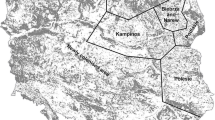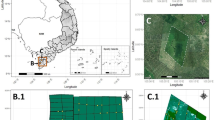Abstract
Monitoring of breeding success in wildlife is key for evaluating population trends and support conservation measures. However, it is challenging depending on breeding places or non-accessible habitat. In recent years, new technologies were applied to studies of bird biology, i.e. drones. UAV (drones) are available to study new aspects of bird ecology, which are not available using traditional methods. The Raven Corvus corax predominantly nests in upper tree canopies or on high cliffs. Hence, it is challenging to monitor it breeding success from the ground. Our study were conducted in forests in NE Poland, on the 77 arboreal Raven nests in 2021–2022. By using drones, we investigated (i) whether the classic data on breeding success from ground observations differ from those of nest inspections via drone, and (ii) to what extent the adult birds behave when the drone is used at the nest. The inspection from the ground failed to determine the contents of as many as 30% of the occupied nests. Inspections using a drone and those made from the ground yielded different results, as aerial assessment showed a higher number of the young (respectively 1.93 vs. 3.22 per successful brood). Broods with three young accounted for 6.5% of nests controlled from the ground and 23.3% using a drone, while broods with two young accounted for 33.8% and 10.4% of nests, respectively. During most of the inspected nests (65% of the cases), adult birds sat nearby in the tree tops and called. In 12% of the cases, the birds flew close to the nest, passing the drone at a distance of more than 20 m, and did not attempt to approach the device. In four cases, adult birds closed the drone at less than 10 m. A direct collision did not happen. The most vital reactions were recorded in several instances (only 4.2%) in which the birds were not near the nest when the inspection began but arrived during the inspection. Drone surveys have revealed previously un-described behavior of birds, alarmed at the examination of empty nests. In 50 nests, 65% of the cases, the Raven tolerated the drone’s presence at the nest, although the birds showed concern and occasionally defensive reactions. It seems that the adverse reaction of birds is weaker when they associate the appearance of a drone with human presence. Key recommendations: control in teams of two - operator and observer, starting end landing in close vicinity of the nest tree, immediate interruption of flight if birds react, forbade flying directly over the nest. It is advisable to check the reaction of adult Ravens to drone inspections of nests with small nestlings. To sum up, our study showed that the drone inspections did not harm the adult birds but provides a more reliable data for reproduction than the observation from ground.
Zusammenfassung
Auf den Schwingen des Raben: Nestkontrollen mit Hilfe von Drohnen.
Die Kontrolle des Bruterfolgs wilder Tiere ist entscheidend für die Einschätzung von Populationstrends und unterstützende Schutzmaßnahmen. Je nach Zugänglichkeit von Brutplatz oder Habitat kann diese jedoch eine Herausforderung darstellen. In den letzten Jahren sind neue Methoden angewendet worden, um die Biologie von Vögeln zu untersuchen, nämlich Drohnen. Unbemannte Luftfahrzeuge (Drohnen) können benutzt werden, um neue Aspekte der Vogelökologie zu untersuchen, die nicht mit Hilfe traditioneller Technologien untersucht werden können. Der Kolkrabe Corvus corax brütet hauptsächlich hoch oben in Baumkronen oder auf hohen Klippen. Daher ist es schwierig, seinen Bruterfolg vom Boden aus zu kontrollieren. Unsere Studie wurde 2021–2022 in Wäldern im Nordosten Polens an 77 Rabennestern in Baumkronen durchgeführt. Mit Hilfe von Drohnen haben wir untersucht, i) ob die klassischen vom Boden aus gewonnenen Daten über den Bruterfolg sich von denen aus Nestinspektionen via Drohnen unterscheiden und ii) wie sich die Altvögel verhalten, wenn eine Drohne am Nest benutzt wird. Eine Untersuchung vom Boden aus konnte den Inhalt von nicht weniger als 30% der besetzten Nester nicht ermitteln. Nestinspektionen vom Boden aus und mit Drohnen lieferten unterschiedliche Ergebnisse, da bei Inspektion aus der Luft mehr Jungvögel sichtbar waren (1,93 verglichen mit 3,22 pro erfolgreiche Brut). Bruten mit drei Jungvögeln machten 6,5 % der vom Boden kontrollierten Nester aus und 23,3 %, wenn eine Drohne benutzt wurde, während Bruten mit zwei Jungvögeln 33,8 % bzw. 10,4 % der Nester ausmachten. Während der meisten Nestinspektionen (65 % der Fälle) saßen Altvögel in nahegelegenen Baumkronen und riefen. In 12 % der Fälle näherten sich die Vögel dem Nest, flogen in mehr als 20 m Entfernung an der Drohne vorbei und versuchten nicht, sich dem Gerät zu nähern. In vier Fällen näherten sich die Vögel der Drohne auf weniger als 10 m. Eine direkte Kollision erfolgte nicht. Die heftigsten Reaktionen wurden in den wenigen Fällen (nur 4,2 %) beobachtet, in denen die Vögel bei Inspektionsbeginn nicht in der Nähe des Nests waren, sondern später im Verlauf der Inspektion ankamen. Untersuchungen mit Drohnen haben bislang nicht beschriebenes Verhalten der Vögel offenbart, die sich bei Inspektion leerer Nester alarmiert zeigten. An 50 Nestern (65 % der Fälle) tolerierten die Vögel die Anwesenheit der Drohne, wobei sie beunruhigt waren und gelegentlich Verteidigungsverhalten zeigten. Offenbar fällt die feindliche Reaktion der Vögel schwächer aus, wenn sie das Erscheinen einer Drohne mit der Anwesenheit von Menschen in Verbindung bringen. Wichtige Empfehlungen: Kontrollen in Zweierteams durchführen und die Drohne nah beim Nistbaum starten und landen, den Flug sofort abbrechen, wenn die Vögel reagieren, direktes Überfliegen des Nests verbieten. Es empfiehlt sich, die Reaktion der adulten Raben auf Drohneninspektionen von Nestern mit noch kleinen Nestlingen zu prüfen. Zusammenfassend zeigte unsere Studie, dass die Drohneninspektionen den Altvögeln keinen Schaden zufügten und zuverlässigere Daten zum Bruterfolg liefern als Beobachtungen vom Boden aus.



Similar content being viewed by others
Data avaibility
The data that support the findings of this study are available from the corresponding author upon request.
References
Afán I, Máńez M, Díaz-Delgado R (2018) Drone monitoring of breeding waterbird populations: the case of the Glossy Ibis. Drones 2:42. https://doi.org/10.3390/drones2040042
Barnas AF, Chabot D, Hodgson AJ, Johnston DW, Bird DM, Ellis-Felege SN (2020) A standardized protocol for reporting methods when using drones for wildlife researches. J Unmanned Veh Sys 8:89–98. https://doi.org/10.1139/juvs-2019-0011
Baxter PW, Hamilton G (2018) Learning to fly: integrating spatial ecology with unmanned aerial vehicle surveys. Ecosphere 9:e02194. https://doi.org/10.1002/ecs2.2194
Borrelle SB, Fletcher AT (2017) Will drones reduce investigator disturbance to surface-nesting seabirds? Mar Ornithol 45:89–94
Cantu de Leija A, Mirzadi RE, Randall JM, Portmann MD, Mueller EJ, Gawlik DE (2023) 1A meta-analysis of disturbance caused by drones on nestling birds. J Field Ornith 94:3. https://doi.org/10.5751/JFO-00259-940203
Cenian Z (2022) Monitoring produktywności bielika. Biuletyn Komitetu Ochrony Orłów 20:7–10
Chabot D, Bird M (2015) Wildlife research and management methods in the 21st century. Where do unmanned aircraft fit in? J Unmanned Veh Sys 3:137–155
Collins SA, Giffin GJ, Strong WT (2019) Using flight initiation distance to evaluate responses of colonial-nesting Great Egrets to the approach of an unmanned aerial vehicle. J Field Ornith 90:382–390. https://doi.org/10.1111/jofo.12312
Cramp S, Perrins C M (1994) Handbook of the birds of Europe, the Middle East and North Africa. The Birds of the Western Palearctic: Crows to Finches, Oxford University Press, Oxford.
Gallego D, Sarasola JH (2021) Using drones to reduce human disturbance while monitoring breeding status of an endangered raptor. Remote Sens Ecol Conserv 7:550–561. https://doi.org/10.1002/rse2.206
Heinrich B (1999) Mind of the Raven. HappenCollins Publishers, New York
Hodgson JC, Koh LP (2016) Best practice for minimising unmanned aerial vehicle disturbance in wildlife in biological field researches. Cur Biol 26:404–405. https://doi.org/10.1016/j.cub.2016.04.001
Junda J, Greene E, Zazelenchuk D, Bird DM (2016) Nest defence behaviour of four raptor species (Osprey, Bald Eagle, Ferruginous Hawk and Red-Tailed Hawk) to a novel aerial intruder—a small rotary-winged drone. J Unmanned Veh Sys 3:222–236
Lachman D, Conway C, Vierling K, Matthews T (2020) Drones provide a better method to find nests and estimate nest survival for colonial waterbirds: a demonstration with Western Grebes. Wetl Ecol Manag 28:837–845. https://doi.org/10.1007/s11273-020-09743-y
Marchowski D (2021) Drones, automatic counting tools, and artificial neural networks in wildlife population censusing. Ecol Evol 11:16214–16227. https://doi.org/10.1002/ece3.8302
Mo M, Bonatakis K (2022) An examination of trends in the growing scientific literature on approaching wildlife with drones. Drone Syst Appl 10:111–139. https://doi.org/10.1139/dsa-2021-0003
R Core Team (2023) R: A language and environment for statistical computing. R Foundation for Statistical Computing, Vienna, Austria
Ratcliffe D (1997) The Raven. Poyser, London
Scarton F, Valle RG (2022) Comparison of drone vs. ground survey monitoring of hatching success in the black-headed gull (Chroicocephalus ridibundus). Ornithol Res 30:271–280. https://doi.org/10.1007/s43388-022-00112-2
Sergio F, Rizzolli F, Marchesi L, Pedrini P (2004) The importance of interspecific interactions for breeding-site selection: peregrine falcons seek proximity to raven nest. Ecography 27:818–826
Sokołowski A (2010) Puszcza Augustowska. CILP, Warszawa
Tryjanowski P (2001a) Does the European hare Lepus europaeus avoid raven Corvus corax nest in farmland? Z Jagdwiss 47:63–66
Tryjanowski P (2001b) Proximity of raven Corvus corax modifies breeding bird community in an intensively used farmland. Ann Zool Fennici 38:131–138
Weissensteiner MH, Poelstra JW, Wolf JBW (2015) Low-budget ready-to-fly unmanned aerial vehicles: an effective tool for evaluating the nesting status of canopy-breeding bird species. J Avian Biol 46:001–006. https://doi.org/10.1111/jav.00619
Zawadzka D (1996) Rozmieszczenie, wybiórczość środowiskowa, pokarm i rozród kruka (Corvus corax) w Wigierskim Parku Narodowym. Not Orn 37:225–245
Zawadzka D (2006) Kruk. Monografie przyrodnicze 15. Klub Przyrodników, Świebodzin
Zawadzki G, Zawadzka D (2017) Wybór drzew gniazdowych myszołowa, jastrzębia i kruka w Puszczy Augustowskiej. Sylwan 161:669–676
Zbyryt A (2018) Oddziaływanie dronów na ptaki oraz ich zastosowanie w badaniach ornitologicznych i ochronie. Ornis Pol 59:56–70
Zbyryt A, Menderski S (2017) Wskazówki metodyczne do inwentaryzacji gniazd czapli siwej Ardea cinerea i czapli białej A. alba w koloniach lęgowych. Ornis Pol 58:197–202
Zbyryt A, Dylewski Ł, Morrelli F, Sparks TH, Tryjanowski P (2020) Behavioural responses of adult and young white storks Ciconia ciconia in nest to an unmanned aerial vehicle. Acta Ornithol 55:243–251. https://doi.org/10.3161/00016454AO2020.55.2.009
Zbyryt A, Jankowiak Ł, Jerzak L, Tryjanowski P (2021) Head and body orientation of the white stork Ciconia ciconia during incubation: effect of wind, apex predators and power lines. J Ornithol 163:181–189. https://doi.org/10.1007/s10336-021-01920-x
Acknowledgements
We would like to thank to Dr Artur Mikitiuk for the linguistic corrections. We are grateful to Dr Sascha Rösner and anonymous Reviewer for their helpful comments and suggestions for improving the manuscript.
Funding
The study was conducted basing on our own funds, unsupported by any institutions.
Author information
Authors and Affiliations
Contributions
GZ conceptualisation (lead); investigation (equal); methodology (lead); data collection (equal); formal analysis (lead); visualisation (lead); writing-original draft (lead); writing-review and editing. DZ conceptualization; investigation (equal); methodology; data collection (equal); writing-original draft; writing-review and editing (lead).
Corresponding author
Ethics declarations
Conflict of interest
The authors have no competing interests to declare that are relevant to the content of this article.
Ethical approval
This study complies with current Polish and European law. The Regional Nature Conservator in Bialystok approved for this research project (approval number: WPN.6401.69.2021.DO).
Additional information
Communicated by O. Krüger.
Publisher's Note
Springer Nature remains neutral with regard to jurisdictional claims in published maps and institutional affiliations.
Rights and permissions
Springer Nature or its licensor (e.g. a society or other partner) holds exclusive rights to this article under a publishing agreement with the author(s) or other rightsholder(s); author self-archiving of the accepted manuscript version of this article is solely governed by the terms of such publishing agreement and applicable law.
About this article
Cite this article
Zawadzki, G., Zawadzka, D. As the Raven flies: nest control with drones. J Ornithol (2024). https://doi.org/10.1007/s10336-024-02148-1
Received:
Revised:
Accepted:
Published:
DOI: https://doi.org/10.1007/s10336-024-02148-1




